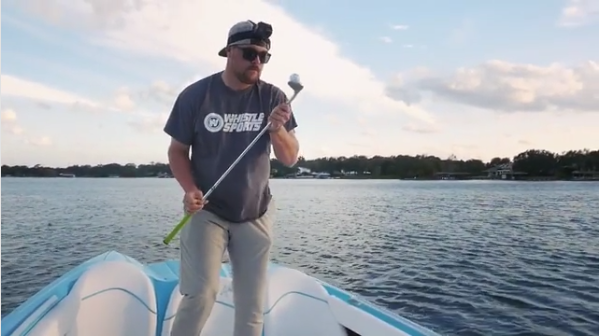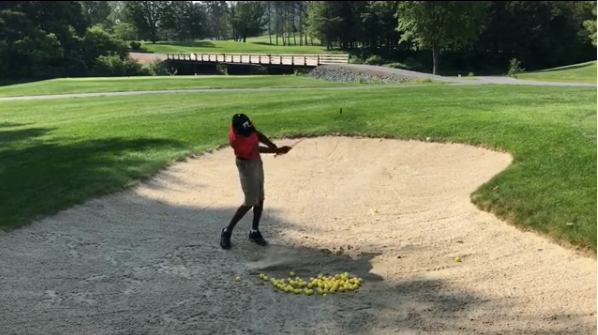Welcome to the World of Swaggy Golf Instagram
How Golf Found A Place On Instagram
Trick-shot redemption.


Technically perfect golf is, by design, boring. You hit the ball as straight as you can onto the shortest grass you can find, until you get the ball into the hole, where there is no grass, in the fewest number of strokes you can manage. Do this eighteen times in a row, and voila, you’ve just played a great round and also made everyone watching you pay attention to something else. Though physical stamina and technical ability are both necessary for playing competently, being a good golfer is more about achieving a zen-like state in which the mind is clear from doubt or even expectation, so that muscle memory can kick in and do the rest.
Hitting a tee shot 275 yards or imparting backspin with a seven-iron is a bit like flying in the Hitchhiker’s Guide to the Galaxy books: the only way to do the thing is to very intently concentrate on absolutely not thinking about the thing. Focus on outcome rather than process, and you’ll end up flying the green, hooking your ball into the water, or doing that super embarrassing thing where you take this big-ass swing then only hit the top of the ball so that it dribbles 50 yards and makes you want to shrink into nothingness and then die. The only way to avoid this stuff is to remember that what you’re doing is, fundamentally, not about other people. It’s about quieting the noise in your head and getting out of your own way.
Contrast this with Instagram, a service where strangers give validation to people who dedicate their accounts to doing the absolute most all the time. Philosophically, golf should not work here. But tons of people love golf, and lots of those people want to engage with golf stuff on Instagram, so you bet your ass somebody was going to figure out a way to make golf work on Instagram, and at some point, perhaps inevitably, it was going to involve a speedboat. Consider this video, which finds a guy standing on said speedboat, using a wedge to juggle a golf ball like Tiger Woods in that one Nike commercial, catching it on the top of his club, and casually flicking it off the back of the boat to another guy who’s surfing in its wake, who then hits the moving ball with a driver.
The “star” of the video is @coach_rusty, a self-described “golf trickshot artist” who lives in northern Virginia and does not give one iota of a fuck. He will sink a putt using a moving fidget spinner as a putterhead. He will juggle a golf ball while standing 30 feet in the air on a tree branch, then lazily send it bouncing off the top of a golf cart down to his bro so he can hit it while it’s still in motion. He will hit a ball, then hit another ball that hits the first ball. He will use a golf club to hit a soccer ball into the crossbar of a soccer goal. He will use a golf ball to set off a Rube Goldberg-esque contraption that ends with a Hot Wheels car knocking a golf ball onto a block of wood, and then hit it off the bounce with his driver. He will do this, which is way too complicated for me to explain.
Coach Rusty is part of a larger network of swaggy instagram golf trick shot artists that includes Steel Lafferty, a professional wakeboarder/amateur golfer you might recall from that speedboat video; Joshua Kelly aka @holein1trickshots, whose bro-y golf posts incorporate guns, hoverboards, and beer pong; and @coach_rusty’s girlfriend, with whom he celebrated Valentine’s day by doing trick shots at the driving range.
Because golf is inherently sort of boring, Coach Rusty and his compatriots tends to spice things up by slowing footage of himself down and setting to the type of EDM trap that sounds like the producer sampled a tennis ball shooter. Often, when he completes one of his trick shots, he celebrates with the gusto of a person who has just base-jumped from the moon to the earth, or at the very least won an actual golf tournament.
In professional golf, meanwhile, great shots tend to follow monumental fuckups, and part of what makes them so jaw-dropping is that the sense of redemption — not only did Bob Golfman regain his resolve, but he overcame the type of pressure that comes with having to correct a very public and high-stakes error. Take the two most impressive golf shots I can think of: Tiger Woods’ chip-in at the 2005 Masters, and Bubba Watson hooking a gap wedge 150 yards out of the woods and onto the green at the 2012 Masters. Prior to both of these shots, Tiger and Bubba had made mistakes — Tiger’s tee shot had missed the green and had ended up wedged between the green and the fringe, while Bubba had sliced his drive into some trees and now had to hit his approach off a bunch of sticks and leaves and stuff. Tiger somehow managed to will his ball onto the exact trajectory he needed to sink a birdie; Bubba literally managed to defy physics and land within 15 feet of the pin to save par.
Chip-ins and successful recovery shots are things a player like me might make by accident, unlikely highlights in a round full of similar mistakes and lots of unsuccessful attempts at saving par. These guys, meanwhile, each made their shots on the last day of the Masters and each won the tournament — in other words, part of what made them so amazing is that they were in the greater context of a round characterized by the unflashy consistency that defines great golf.
In his own way, Coach Rusty too is a professional golfer, at least in the sense that he gets paid to do golf stuff. His videos and photos often incorporate branded sponsorships, and he has posted content on behalf of Honda, DraftKings, Swannies Apparel, Callaway golf clubs, Gios headcovers, and Birds of Condor golf hats, which he calls “swaggiest in the game.” He and Kelly, a frequent collaborator, are repped by the Golf Stars Agency, whose site boasts that the company aids “the world’s top golf social media influencers in partnering with endemic and non-endemic sponsors who want to re-imagine the way consumers connect with their brands.” It’s almost as if the community’s aesthetic, so reliant on trap music and elaborate staging to create isolated moments of incredulity that are only tangential to golf as we know it, has been tailored to fit in with the greater Instagram economy.
Sometimes, I worry about Coach Rusty. He’s obviously a pretty good golfer; otherwise, he wouldn’t be able to chip this miniature football into a hole on behalf of the NFL Network. But are his posts’ manic positivity, high production values, and seamless brand integration the mark that he’s secretly the golf version of those #vanlife people? Is he doomed to put in so much time and effort into creating content that appeases the companies who underwrite his swaggy golf lifestyle that he ends up spending less time on the course than if he had a real job and played golf on the weekends? Is Coach Rusty even allowed to play a round of golf without his GoPro strapped to his head?? My heart wants the answer to be yes, but the fact that he had to learn how to ride a balance board to make this clip that ends with him jumping into a pool while biting into a beer can strongly suggests that the answer is extremely not yes.
Perhaps the best representation of actual golfing on Swaggy Golf Instagram is @md_18undapar, a 13 year-old junior golfer named Matty Du Plessis whose innate charisma makes Coach Rusty’s excesses seem even more ridiculous. Unlike Coach Rusty and his cohort, most of his clips consist of him just hitting shots on the course, sometimes set to the sort of rap music that 13-year-olds like, sometimes not.
For the most part, his videos aren’t all that impressive unless you’re, like, actually into golf, and even then, most of their joy comes as a result of Du Plessis’s enthusiasm for working hard, getting better, and showcasing his progress along the way. Though he does occasionally post novelty videos — including the occasional trick shot — they rarely seem designed to plug his sponsors. He’s cooked eggs using his expensive Bridgestone wedges as kitchen utensils, and remade the Notorious B.I.G.’s “Juicy” to be all about golf.
Lately, he’s been accepting “challenges” from his fans (he calls his fans “Barahs,” which I don’t really understand, but then again I’m not 13) to do stuff like make a par using only a specific club. When he accepted a “challenge” to hit his driver 200 yards with the headcover still on it and couldn’t make it happen, he posted the video of himself trying and failing. Simply by being himself, Du Plessis makes the greater tenets of golf — humility, mental acuity, acceptance — seem like swaggy qualities to possess.
My favorite of Du Plessis’s recent posts finds him hitting off barren ground, trees blocking his ball’s path to the green. Much like Bubba Watson at the 2012 Masters, he’s wound up in the woods and now needs to recover. Calmly, he squares up to the ball, wiggles his club a couple times, and proceeds to hit a low, straight shot heading straight towards the pin. He watches the ball fly for a moment, then, satisfied, turns around and pats his chest for the camera. In the caption, he lets his fans know he ended up getting a birdie on the hole. He shot four under par for the round.
Drew Millard is a freelance writer based in Durham, NC. Follow him on Twitter: @drewmillard
